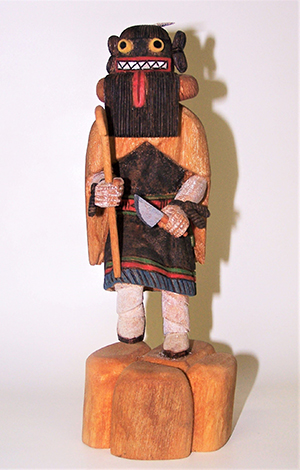Hopi Ogre Woman Kachina
 The Hopi live on more than 1.5 million acres of reservation land in northeastern Arizona. They are known for many art forms, including the carving of kachina dolls or figures. These carvings are the physical representations of Hopi spirits. There are upwards of 500 different spirits, each with its own accessories and attributes.
The Hopi live on more than 1.5 million acres of reservation land in northeastern Arizona. They are known for many art forms, including the carving of kachina dolls or figures. These carvings are the physical representations of Hopi spirits. There are upwards of 500 different spirits, each with its own accessories and attributes.
The Hopi call a single spirit or figure katsina. The name kachina is the result of translation errors. Katsina spirits provide for, protect, and teach humankind. The Hopi believe that they visit the mesas from January to July to bless the people with rain, abundant crops, fertility, good health, knowledge, and other gifts. When they are not visiting, the Hopi believe Katsina spirits reside at the sacred place called Nuvatukya’ovi, the San Francisco Peaks.
Traditionally, only Hopi men who were initiated in the Katsina religion made katsina figures. Each figure was carved by hand from a single piece of cottonwood root, then meticulously painted and decorated. Today, katsina carving is still primarily the domain of Hopi men. Katsina figures are given to young Hopi girls as gifts to bring happiness, wealth, and health in the future. They are also used as educational tools to teach girls about Hopi beliefs.
Katsina figures that are made to be sold, like this one, are called katsintihu by the Hopi. Although they represent a sacred belief system, they are very popular as art pieces.
The spirit represented in this figure is called Soyoko Mana by the Hopi. This figure is distinguished from other ogre women kachinas because of her butterfly whorl hairstyle, which indicates she is not yet married. She carries a knife and crook and has a basket on her back. These items are used to catch her prey, children, and carry them away. Children are expected to provide food for her, and if they don’t, they are told she will eat them instead. She is a disciplinarian of children, teaching and frightening them into good behavior.
This figure is featured in the virtual exhibit Living Arts of the Hopi.
